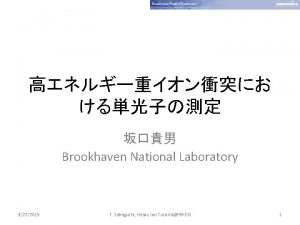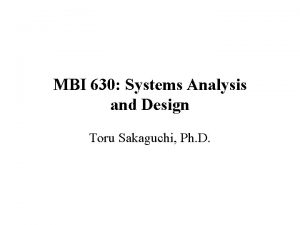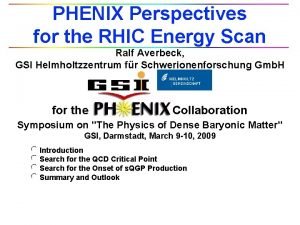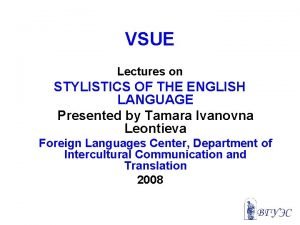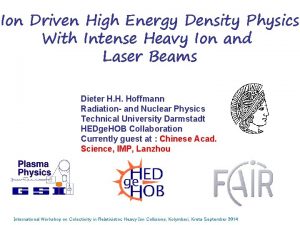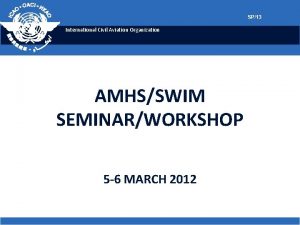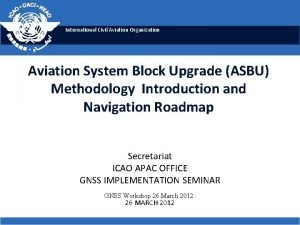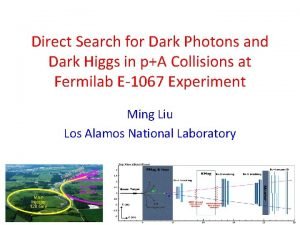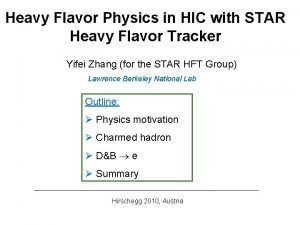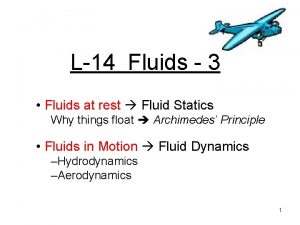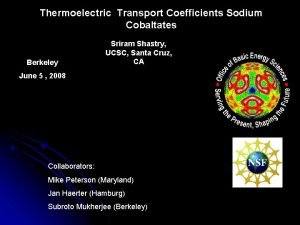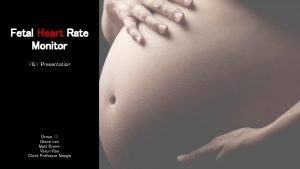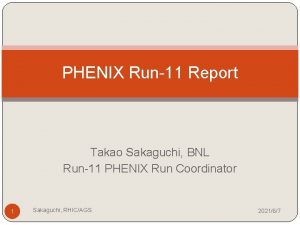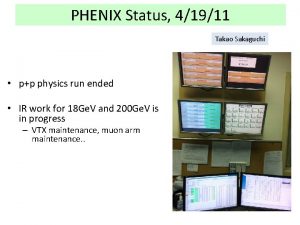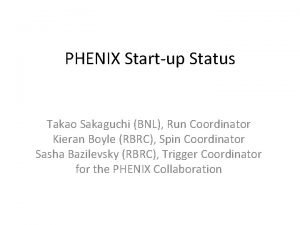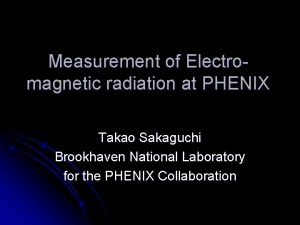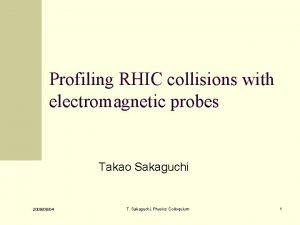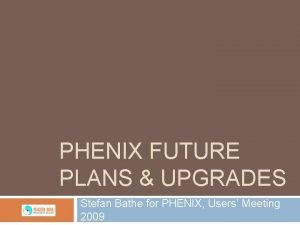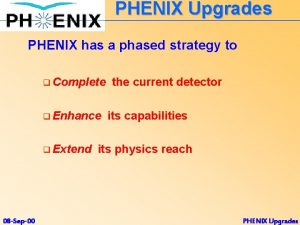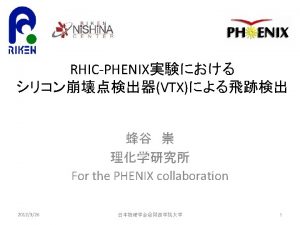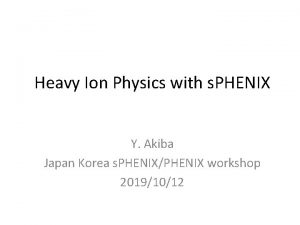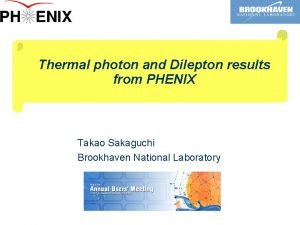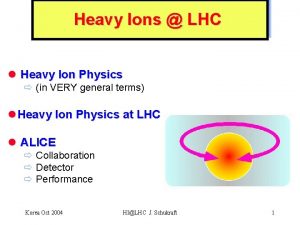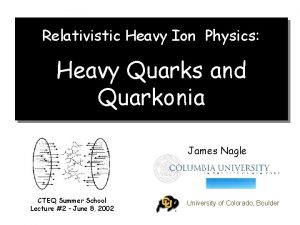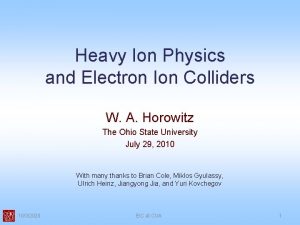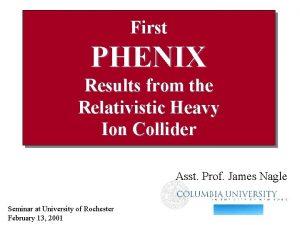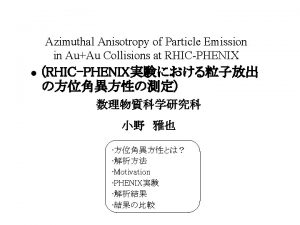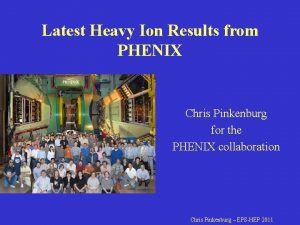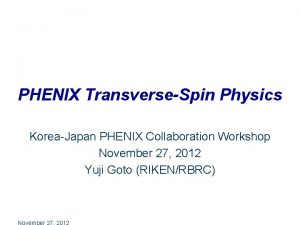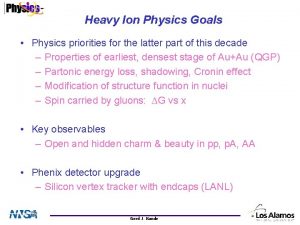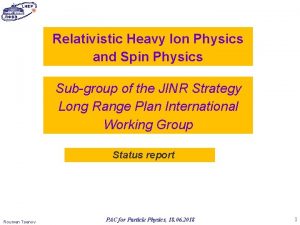Heavy ion physics with PHENIX upgrades Takao Sakaguchi




























- Slides: 28

Heavy ion physics with PHENIX upgrades Takao Sakaguchi Brookhaven National Laboratory For Future direction in High Energy QCD, RIKEN, Oct 20, 2011

PHENIX upgrade plans 2 2011 -10 -20 T. Sakaguchi, Future Directions in HE QCD, RIKEN

Major upgrades for next ~5 years l Hadron Blind Detector (HBD) – – l Resistive Plate Chamber (RPC) & Muon Trigger upgrade – l – – Measure DCA of tracks in forward rapidity region To be installed in Run-12 Muon Piston Calorimeter extension (MPC-EX) (3. 1<|h|<3. 8) – – 3 Measure DCA of tracks, and tag D, B originated electrons Installed in Run-11. Now in repair for Run-12 Forward Vertex Detector (FVTX) – l Installed in Run-11 in Muon Arm. Measure timing of muons in order to select muons from a same bunch-crossing. Silicon Vertex Detector (VTX) – l Tag and reject electron-pairs that have small opening angles (likely due to conversions or Dalitz decay) Installed in Run-10 and completed mission Shower max detector in front of existing MPC Measure direct photons/p 0 in forward rapidity region 2011 -10 -20 T. Sakaguchi, Future Directions in HE QCD, RIKEN

Low mass dilepton issue *Phys. Rev. C 81, 034911 (2010) v Results* from RHIC Run-4: Yield in mee = 0. 15 - 0. 75 Ge. V/c 2 larger by a factor 4. 7 +/- 0. 4(stat. ) +/- 1. 5(syst. ) +/0. 9(model) compared to the expected hadronic contribution v S/B in this mass region is 1/200 v combinatorial background should be reduced! One way is to look at the opening angle of electron-pairs SIMULATION p 0 ->e+e-g 4 f ->e+e- qop 2011 -10 -20 T. Sakaguchi, Future Directions in HE QCD, RIKEN

Hadron Blind Detector l Designed for low-mass dileptons in A+A – Operated in Run-9 and 10 l Removes Dalitz and conversion pairs – Reduce background * signal electron partner positron needed for rejection e Cherenkov blobs e+ q pair opening angle ~1 m Windowless Cerenkov detector with CF 4 avalanche/radiator gas (2 cm pads) 5 2011 -10 -20 Cs. I photocathode covering triple GEMs T. Sakaguchi, Future Directions in HE QCD, RIKEN

HBD performance v The average number of photoelectrons Npe in a Cherenkov counter: N 0 ideal value 714 cm-1 Optical transparency of mesh 88. 5 % Optical transparency of photocath. 81. 0 % Radiator gas transparency 89. 0 % Transport efficiency 80. 0 % with: Reverse bias and pad threshold • N 0 calculated • N expected • bandwidth: 6. 2 e. V (Cs. I photo- pe cathode threshold) - 11. 5 e. V Npe measured N 0 measured value (CF 4 cut-off) 90. 0 % 328 +/- 46 cm-1 20. 4 +/- 2. 9 20 330 cm-1 The highest ever measured N 0! The high photoelectron yield excellent single electron detection efficiency: Single electron efficiency using a sample of open Dalitz decays: ~ 90 % Single electron efficiency derived from the J/Y region: = 90. 6 9. 9 % 6 2011 -10 -20 T. Sakaguchi, Future Directions in HE QCD, RIKEN

Background rejection in p+p Pairs in Central Arms Present status from Run-9 p+p: Background reduction in mee > 0. 15 Ge. V/c 2 (not fully optimized) Pairs matched to HBD Step Bckg. reduction factor 1 matching to HBD 7. 1 2 double hit cut close hit cut 6. 5 7 2011 -10 -20 Pairs after HBD reject. T. Sakaguchi, Future Directions in HE QCD, RIKEN

The HBD analysis in Au+Au (Run-10): Single vs. double charge v Rejection of upstream conversions and p 0 Dalitz pairs is achieved with single/double charge cut v This requires good gain calibration throughout the entire run 8 2011 -10 -20 Singles efficiency v Double electron hits studied using MC p 0 -> embedded in Au+Au data Single efficiency vs. double rejection Doubles rejection v Single electrons hits studied using MC electrons from f->e+e- embedded in Au+Au data T. Sakaguchi, Future Directions in HE QCD, RIKEN

Run-11 PHENIX detector e+/Central Arms: §hadrons, photons, electrons § |η| < 0. 35 § Δφ = π (2 arms x π/2) Global Detectors: §Beam-Beam Counter (BBC) §Zero Degree Calorimeter (ZDC) Muon Arms: § muons § 1. 2 < |η| < 2. 2 § Δφ = 2π MPC u. T rn or T mu th μ+/- mu. ID north mu. ID south RPC 1(a, b) 3. 1 < | η | < 3. 9 RPC 3 9 th u o rs m 2011 -10 -20 RPC 3 T. Sakaguchi, Future Directions in HE QCD, RIKEN

Triggering muons from W l In order to measure W at 500 Ge. V, a first level trigger rejection of a factor 10000 is needed • For heavy ion physics: • Extend capability of accepting ultra peripheral collisions Previous Muon Trigger at PHENIX 10 2011 -10 -20 T. Sakaguchi, Future Directions in HE QCD, RIKEN

Run-11: Single event from Au+Au at 200 Ge. V VTX event display Run # 343450 -0014 Event 13 11 2011 -10 -20 T. Sakaguchi, Future Directions in HE QCD, RIKEN

VTX with FVTX (Run-12 goal) 12 2011 -10 -20 T. Sakaguchi, Future Directions in HE QCD, RIKEN

Heavy quark suppression & flow? FVTX/VTX physics Collisional energy loss? v 2 decrease with p. T? role of b quarks? PRL. 98: 172301, 2007 ar. Xi. V: 1005. 1627 13 2011 -10 -20 T. Sakaguchi, Future Directions in HE QCD, RIKEN

FVTX specific l As far as heavy ion physics is concerned, we might focus on cold nuclear matter (CNM) effect l Resolving J/y and y’ in Muon arms l Direct measure of B meson through displaced J/y l Drell-Yan or J/y Measurements in d. Au at both forward rapidity – – 14 ar. Xiv: 1010. 1246 d + Au J/ Detect quark distribution in nuclei Combining with mid-rapidity results 2011 -10 -20 T. Sakaguchi, Future Directions in HE QCD, RIKEN

VTX/FVTX physics capabilities 8 weeks Au+Au w/VTX In Run-11 ~ two good weeks for VTX Au+Au data taking Run-12 Goal for FVTX: Commission 15 2011 -10 -20 T. Sakaguchi, Future Directions in HE QCD, RIKEN

RHIC (hard) studies in LHC era l Hard probe difference – – More quark jets instead of gluon jets PHENIX can select pure sample of quark jets via -jet correlation (demonstrated in our paper in p+p measurement, PRD 82, 072001 (2010)) l Medium difference LHC ~ 50 -75% gluon jets RHIC ~ 75% quark jets l Key machine flexibillity – p. A, light AA, asymmetric systems such as Cu+Au. 16 2011 -10 -20 T. Sakaguchi, Future Directions in HE QCD, RIKEN

Finding the QCD Critical Point Singular point in phase diagram that separates 1 st order phase transition (at small T) from smooth cross-over (at small b) Quark-number scaling of V 2 • saturation of flow vs collision energy • /s minimum from flow at critical point Critical point may be observed via: • fluctuations in <p. T> & multiplicity • K/π, π/p, pbar/p chemical equilibrium • RAA vs s, …. VTX provides large azimuthal acceptance & identification of beam on beam-pipe backgrounds 17 2011 -10 -20 T. Sakaguchi, Future Directions in HE QCD, RIKEN

A thing we don’t want to throw out 18 2011 -10 -20 T. Sakaguchi, Future Directions in HE QCD, RIKEN

Electromagnetic probes l – – – Compton and annihilation (LO, direct) Fragmentation (NLO) Escape the system unscathed l Carry dynamical information of the state l Temperature, Degrees of freedom – – e+ g* e- Immune from hadronization (fragmentation) process at leading order Initial state nuclear effect l 19 Photon Production: Yield s Production Process Cronin effect (k. T broardening) 2011 -10 -20 g T. Sakaguchi, Future Directions in HE QCD, RIKEN

Possible sources of photons hard scatt jet Brems. parton-medium interaction jet-thermal s. QGP hadron gas hadron decays g* e+evirtuality 0. 5 1 Mass 20 (Ge. V/c 2) 1 10 107 log t (fm/c) By selecting masses, hadron decay backgrounds are significantly reduced. (e. g. , M>0. 135 Ge. V/c 2) 2011 -10 -20 T. Sakaguchi, Future Directions in HE QCD, RIKEN

Low p. T photons with very small mass PRL 104, 132301(2010), ar. Xiv: 0804. 4168 l Focus on the mass region where p 0 contribution dies out l For M<<p. T and M<300 Me. V/c 2 – – l Can be converted to real photon yield using Kroll-Wada formula – One parameter fit: (1 -r)fc + r fd fc: cocktail calc. , fd: direct photon calc. qq -> * contribution is small Mainly from internal conversion of photons Known as the formula for Dalitz decay spectra Internal conv. e+ e- Compton g* q g 21 2011 -10 -20 q T. Sakaguchi, Future Directions in HE QCD, RIKEN

Low p. T photons in Au+Au (thermal? ) l Inclusive photon × dir/ inc l Fitted the spectra with p+p fit + exponential function – l Tave = 221 19 stat 19 syst Me. V (Minimum Bias) Nuclear effect measured in d+Au does not explain the photons in Au+Au PRL 104, 132301(2010), ar. Xiv: 0804. 4168 Au+Au d+Au Min. Bias 22 2011 -10 -20 T. Sakaguchi, Future Directions in HE QCD, RIKEN

Photon source detector l Depending the process of photon production, path length dependence of direct photon yield varies – – v 2 of the direct photons will become a source detector Later thermalization gives larger v 2 jet fragment photon Bremsstrahlung (energy loss) annihilation compton scattering jet v 2 > 0 v 2 < 0 For prompt photons: v 2~0 23 2011 -10 -20 T. Sakaguchi, Future Directions in HE QCD, RIKEN

What we learn from model comparison l Later thermalization gives larger v 2 (QGP photons) l Large photon flow is not explained by models Hydro after t 0 Curves: Holopainen, Räsänen, Eskola. , ar. Xiv: 1104. 5371 v 1 thermal diluted by prompt Chatterjee, Srivastava PRC 79, 021901 (2009) 24 2011 -10 -20 T. Sakaguchi, Future Directions in HE QCD, RIKEN

Another interest ~rapidity dependence~ l Forward direct photons may shed light on time evolution scenario – l Higher rapidity goes, earlier the stage we may be able to explore – l e. g. , priv. comm. K. Itakura. Glasma dynamics, through photons Higher the rapidity goes, higher the baryon density we may be able to reach – l Real photons, *->ee, *->mm BRAHMS plot. Another good way to access to the critical point? MPC-EX and/or Muon arm upgrades in PHENIX (Covering 1<|y|<3) – Needs serious studies of how high in centrality we can go T. Renk, PRC 71, 064905(2005) 25 BRAHMS, PRL 90, 102301 (2003) 2011 -10 -20 T. Sakaguchi, Future Directions in HE QCD, RIKEN

My LHC favorite l A calculation tells that even in low p. T region(p. T~2 Ge. V/c), jet-photon conversion significantly contributes to total l What do we expect naively? (or guessively? ) – – – l Jet-Photon conversions Ncoll Npart (s 1/2)8 f(x. T), “ 8” is x. T-scaling power Thermal Photons Npart (equilibrium duration) f( (s 1/2)1/4 ) Bet: LHC sees huge Jet-photon conversion contribution over thermal? Together with v 2 measurement, the “thermal region” would be a new probe of medium response to partons Jet-photon conversion LHC Thermal p. QCD 26 Turbide et al. , ar. Xiv: 0712. 0732 ~6 Ge. V? 2011 -10 -20 ~15 Ge. V? T. Sakaguchi, Future Directions in HE QCD, RIKEN

Summary l PHENIX has major upgrades in the near term future (~five years) – – – l Many studies to be done at RHIC in LHC era l Direct photon measurement is very important at RHIC. – – – 27 HBD to tag and reject electron-pairs that have small opening angles. Installed in Run-10 and completed mission. Analysis on going. RPC & Muon Trigger to measure timing of muons in order to select muons from a same bunch-crossing. Installed in Run-11 VTX to measure DCA of tracks, and tag D, B originated electrons Installed in Run-11. Now in repair for Run-12 FVTX to measure DCA of tracks in forward rapidity region. To be installed in Run-12 MPC-EX to measure direct photons/p 0 in forward rapidity region Should explore new degrees of freedom: Elliptic flow has been measured. Rapidity dependence of direct photon production is a key to understand time evolution of collision system. High rapidity to find critical points? 2011 -10 -20 T. Sakaguchi, Future Directions in HE QCD, RIKEN

Backup 28 2011 -10 -20 T. Sakaguchi, Future Directions in HE QCD, RIKEN
 It is a computer drawing of the plane of the future
It is a computer drawing of the plane of the future Takao furuno's farm is an example of biomimicry because it
Takao furuno's farm is an example of biomimicry because it Matt sakaguchi
Matt sakaguchi Inductory
Inductory Toru sakaguchi
Toru sakaguchi Shratey calculator
Shratey calculator Phenix scan
Phenix scan Scan trip
Scan trip Jargonisms are
Jargonisms are Professional and social jargonisms
Professional and social jargonisms Heavy ion
Heavy ion Mng extranet
Mng extranet Opmet briefing
Opmet briefing Aviation system block upgrades
Aviation system block upgrades Pans aim
Pans aim Asbu aviation system block upgrades
Asbu aviation system block upgrades Dark sector upgrades
Dark sector upgrades London dispersion forces diagram
London dispersion forces diagram Ion dipolo
Ion dipolo Ejemplo de fuerza ion ion
Ejemplo de fuerza ion ion Fuerzas dipolo dipolo ejemplos
Fuerzas dipolo dipolo ejemplos Heavy flavor physics
Heavy flavor physics Physics ia ib examples
Physics ia ib examples Why does it happen
Why does it happen University physics with modern physics fifteenth edition
University physics with modern physics fifteenth edition Heavy equipment safety poster
Heavy equipment safety poster Fluids at rest
Fluids at rest Fiducary
Fiducary Raceplay
Raceplay



